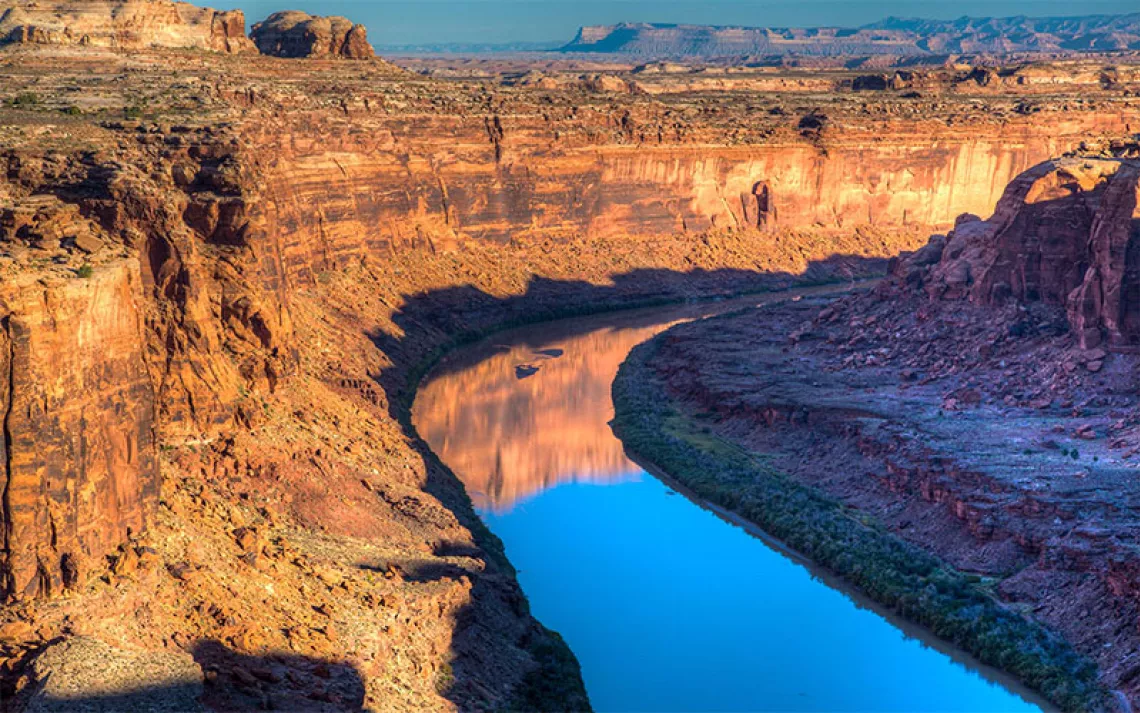Critics Call BLM and USDA Relocations a Gambit to Sell Off Public Lands
The Trump administration appears to be celebrating a federal brain drain

William Perry Pendley is the deputy director of the Bureau of Land Management. (Department of the Interior photograph)
In the span of a few months, entire sections of the US government have been turned upside down with around 1,000 federal employees given a stark choice: relocate or lose your job.
That dilemma lies at the heart of a decision to move parts of two federal departments out of Washington, DC. The Trump administration argues that the relocations are a cost-saving measure that will bring federal workers closer to the people they serve. But opponents say the situation is part of an effort to diminish agency power and force out career officials who have been at odds with President Donald Trump’s policies.
The relocations also come saddled with environmental implications. The Interior Department’s Bureau of Land Management (BLM) will be headquartered in Colorado, a move critics say will help private interests wield influence over public lands. Meanwhile, parts of the Department of Agriculture (USDA) will move to the Midwest at a time when the department is facing allegations of burying climate research.
The fast-moving timeline for the relocations has shocked impacted workers and observers. In mid-July, officials confirmed that 84 percent of DC-based BLM positions would be moved by the end of 2020, with employees given until August 15 to make their decision. A month prior, USDA head Sonny Perdue announced that two USDA research agencies—the Economic Research Service (ERS) and the National Institute of Food and Agriculture (NIFA)—would be moving to Kansas City, which straddles Missouri and Kansas.
USDA employees were initially given until July 15 to decide whether to relocate by September 30; more than half of the hundreds of staffers are believed to have opted out. Those agencies perform critical scientific and economic research largely overseen by experts with years of USDA experience.
A similar scenario is now looming over BLM, and those familiar with the agency are baffled.
“You’re going to have a brain drain. You’re going to lose a lot of expertise,” said George Stone, director-at-large for the Public Lands Foundation (PLF), an organization staffed largely by former BLM employees.
Stone worked for the Interior Department for 30 years, with around a decade at BLM. The former official noted that the agency is already far-flung—roughly 97 percent of staffers are located outside of DC, many of them west of the Mississippi River. DC staffers, Stone said, work largely on internal guidance and direction, in addition to steering legislative affairs.
Now is the time for environmental journalism.
Sign up for your Sierra magazine subscription.

Now, most of those few hundred employees are being asked to move. Twenty-seven are set to go to Grand Junction, Colorado, the new headquarters. The rest will go elsewhere to states like Utah and New Mexico. As with USDA’s relocation, top officials have touted the cost-saving benefits of the change and the potential posed by new locations. When asked for comment, Interior Department spokeswoman Molly Block pointed to a statement by Secretary David Bernhardt arguing that the BLM relocation will serve “the needs of the American people.”
But Stone countered that BLM is already well established nationally and that the agency’s work in DC will be undercut by the move. And while employees will likely be paid less outside of DC, the government will have to pay relocation costs on top of the new long-term expenses posed by traveling to and from remote areas.
“What exactly is the problem that we're trying to solve here?” Stone asked.
Some relocation opponents worry they know the answer to that question. Jesse Prentice-Dunn, policy director for the Denver-based Center for Western Priorities, called the move “a joke” and hypothesized that it might be part of a bigger effort to sell off public lands. He pointed to the selection of acting BLM Director William Perry Pendley, who Bernhardt appointed in July. Pendley has long advocated for the privatization of public lands and is one of only tens of employees who would remain in DC following the relocation.
BLM has been without an official director throughout the Trump administration. Directors are typically nominated by the president before undergoing a Senate confirmation process. But BLM’s current power void has left control with Bernhardt, allowing Pendley to rise to the top.
The choice of Pendley coupled with the relocation, Prentice-Dunn said, indicates that the Trump administration “is trying to dismantle” BLM. Others seconded that opinion, including Chris Saeger, director of the Western Values Project, a nonprofit based in Montana.
“No question that this is an attempt to slowly dismantle public lands,” Saeger asserted.
Critics also see the relocation as a partisan favor. Senator Cory Gardner (R-CO), who is facing a tight reelection battle in 2020, has pushed for the shift as a move beneficial to his state and touted the news in a Twitter video. Colorado GOP Chairman Ken Buck similarly linked the move to Gardner and called it “a victory for our state.” While some Democrats support the decision, like Colorado governor Jared Polis, Republicans in western states have been among the biggest proponents.
For many impacted workers, however, the move is compounding an already untenable situation. Morale is running low across all federal agencies due to attrition and clashes between career staff and political appointees. Many employees were also blindsided by the decision.
“We hear that no one at BLM was involved in the planning,” Stone said, relaying that senior executives were largely told about the move just prior to the announcement at the all-staff DC meeting. He added that he was unclear how many BLM employees would relocate but estimated that the number might be small.
While BLM staffers struggle to decide, the USDA relocation has already sparked a brain drain. The employees’ union, AFGE, said that more than 50 percent of staffers at both NIFA and ERS have declined to leave or not responded, numbers that USDA has confirmed. A last-minute deal on Friday between AFGE and USDA will allow some employees to telework for at least a few months, in addition to giving them until September 27 to change their minds about relocating. But hundreds could still be removed from their jobs following that date, even after they voted to unionize largely to stop the Kansas City plan.
Rather than expressing dismay at that loss, the Trump administration has appeared to celebrate it. Mick Mulvaney, Trump’s acting chief of staff and budget head, has lauded the mass attrition as “a wonderful way to sort of streamline government” and part of a larger “drain the swamp” effort.
Comments like that are drawing scrutiny from watchdog organizations, with some already deeply suspicious of the relocations. “[It’s] downright dubious to the point of being duplicitous,” said Jeff Ruch, Pacific director for Public Employees for Environmental Responsibility (PEER).
Ruch linked the BLM and USDA moves to wider environmental issues, even as he spelled out the differences between the two relocations. At USDA, career staff have routinely produced reports about climate change. That work has proven volatile—a July investigation by Politico found that USDA has sought to bury department climate reports because they are out of step with the Trump administration’s policies. Employees also speculated that both NIFA and ERS are being moved as a warning to other agencies within USDA who fail to fall in line.
BLM’s move is more surprising, Ruch said. Under Trump, the Interior Department has scaled back national monuments and sought to open up public lands for oil and gas drilling. By Ruch’s characterization, BLM leadership has embraced these efforts, a trend that predates Trump and has occurred under both Democratic and Republican administrations. “[BLM] hardly ever says no,” Ruch said.
Some opponents have speculated that the move may be meant to further entrench that dynamic. And oil and gas industry advocates, including Kathleen Sgamma of Western Energy Alliance, have expressed that the BLM relocation could be beneficial for fossil fuels.
Regardless of the rationale behind it, the BLM move could run into the same problems as USDA. An August 2019 report by USDA’s Office of Inspector General (OIG) found that the department is within its legal rights to relocate—but it does not necessarily have the budget rights, as power of the purse lies with Congress.
That lends fuel to skeptical Democrats, even as USDA asserts it has broken no laws despite acting without congressional sign-off. And while USDA’s relocation is well underway, those opposing the BLM move are hoping that lawmakers may similarly step in. The House Natural Resources Committee is planning to hold a hearing on the issue in September, and Chairman Raúl Grijalva (D-AZ) has said he will probe the justification for the decision. Senator Lisa Murkowski (R-AK), who chairs the Senate Appropriations Interior-Environment Subcommittee, has also indicated that she wants more information about the relocation costs.
If nothing comes of that scrutiny, options may be limited for workers, with many likely forced to resign like their USDA counterparts. Asked to describe the long-term plan for opponents, Stone was candid about the approach many are taking.
“I think part of the strategy among those who oppose this is to drag it out until November 2020,” he said.
 The Magazine of The Sierra Club
The Magazine of The Sierra Club



